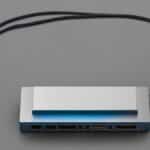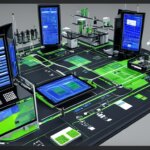Table of Contents
When it comes to computer networking, one of the essential components is the Network Interface Card, commonly referred to as NIC. But what exactly is a NIC and what role does it play in establishing network connectivity? In this article, we’ll explore the basics of NIC in computer networking, its definition, functions, and why it is important in ensuring seamless communication between devices on a network.
NIC acts as a bridge between the computer and the network, enabling data transmission, reception of signals and handling network protocols. It is responsible for converting digital data from the computer into electrical signals so that it can be transmitted over a network and vice versa. Without a NIC, a computer cannot communicate over a network.
In the next section, we will provide a detailed definition of NIC and its functions.
Key Takeaways
- NIC (Network Interface Card) is an essential component of computer networking that acts as a bridge between the computer and the network.
- A NIC is responsible for data transmission, reception of signals and handling network protocols.
- Without a NIC, a computer cannot communicate over a network.
- NIC is available in different types and can affect network performance and efficiency.
- Understanding NIC is crucial to establishing a smooth and efficient network.
What is a NIC?
A NIC or Network Interface Card is a hardware component in computer networking that allows a device to connect to a network.
The function of a NIC is to facilitate data transmission between a computer and a network. It handles data packets by sending and receiving signals, and it works with network protocols to ensure effective communication.
Hence, a NIC can be thought of as an intermediary between a computer and a network. It is responsible for translating digital data from the computer into signals that can be transmitted over the network and vice versa.
Overall, a NIC is a critical component of computer networking that ensures seamless network connectivity.
Importance of NIC in Networking
Network Interface Card or NIC is a vital component for establishing connectivity in a network. The significance of NIC lies in its ability to act as a bridge between the computer and the network, allowing devices to communicate effectively, and transmit data packets with proper integrity and speed.
The importance of NIC in networking cannot be overstated. Without an effective NIC, a computer cannot communicate with other devices on the network, undermining the entire system’s performance. NIC enables computers to connect to wired or wireless networks, providing them with a unique identity or MAC address that distinguishes them from other devices on the network.
Different types of NICs are available on the market, ranging from basic to advanced models, and each type contributes to network performance and efficiency in various ways. Gigabit NICs, for instance, support higher bandwidths and faster data transfer rates, enhancing network performance.
In conclusion, NIC is a crucial component in computer networking, and its importance in facilitating effective communication and network performance cannot be overlooked. Different types of NICs play a vital role in improving network performance, making them an essential part of any network setup.
Conclusion
To sum up, NIC (Network Interface Card) is an integral part of computer networking. It plays a crucial role in establishing connectivity between devices on a network. The functions of NIC include transmitting data, receiving signals, and handling network protocols. Without NIC, it would be impossible for devices to communicate effectively over a network.
Moreover, NIC acts as a bridge between the computer and the network. It allows data to be exchanged between devices in a seamless and efficient manner. Different types of NICs are available, each with its unique features contributing to network performance and efficiency.
In conclusion, NIC is a key component of computer networking. Its importance cannot be overstated. As we continue to rely more on networks for communication and data sharing, the role of NIC will become increasingly crucial. Understanding NIC and its functions is an essential aspect of networking that every IT professional should master.
FAQ
What is a Network Interface Card (NIC)?
A Network Interface Card (NIC) is a hardware component that allows a computer to connect to a network. It serves as the interface between the computer and the network, enabling data transmission and communication.
What are the functions of a NIC in computer networking?
A NIC performs several functions in computer networking. It facilitates the transmission of data between the computer and the network by converting digital signals into analog signals for transmission over a network medium. It also receives signals from the network and converts them into digital data that the computer can understand. Additionally, a NIC handles network protocols and manages the flow of data between the computer and the network.
Why is a NIC important in networking?
NIC plays a crucial role in networking as it acts as a bridge between the computer and the network. It allows devices to connect and communicate effectively, enabling the exchange of data and information. Different types of NICs contribute to network performance and efficiency, allowing for reliable and fast data transfer.
How does a NIC contribute to network performance?
A high-quality NIC can enhance network performance by providing faster data transfer rates and reducing latency. Advanced NICs often come with features like advanced network offloading and support for network virtualization, making them essential for modern networking requirements.
Can I upgrade my computer’s NIC?
Yes, you can upgrade your computer’s NIC. Upgrading to a newer and faster NIC can improve network connectivity and performance. However, it is essential to ensure compatibility with your computer and the network infrastructure.
Do all computers have a NIC?
Most modern computers come with a built-in NIC to support network connectivity. However, in some cases, older computers may not have a built-in NIC. In such instances, an external NIC can be added to enable network connectivity.












